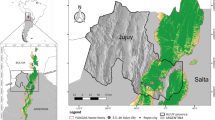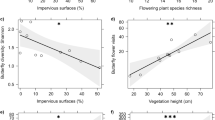Abstract
Through the rapid expansion worldwide of impervious areas and habitat fragmentation, urbanization has strong consequences that must be understood to efficiently manage biodiversity. We studied the effects of urbanization on flower-feeding insects by using data from a citizen science program in the Parisian region. We analysed the occurrence of insects from 46 different families on flowers of different morphologies, using landscape indices in buffer areas from a 100-m to a 4000-m radius around 1194 sampled sites. Our aims were to determine (i) how the proportion of impervious area around sampled sites affected the occurrence of flower-feeding insect families and at which landscape scales impervious area calculations best predicted these occurrences; (ii) the effect of corolla shape variables on insect family occurrences. Twenty-one families were negatively impacted by increasing proportion of impervious areas (urbanophobic) and 3 were positively impacted (urbanophilic). Urbanophobic families were most affected by the proportion of impervious areas when it was estimated within buffers of 200-m to 1400-m radii, depending on the family. Notable losses of urbanophobic families were detected at less than 50% of impervious areas, which highlights the threat to the diversity of flower-feeding insects posed by urban sprawl. Corolla shape variables were the variables most often significantly implicated in the occurrence of insect families. Urbanophobic families were negatively affected by the tubular shape of flowers, and tubular corollas were found more often in urbanized areas. These results suggest that flora management might be a key component for the conservation of insect diversity in cities.







Similar content being viewed by others
References
Ahrné K, Bengtsson J, Elmqvist T (2009) Bumble bees (Bombus spp) along a gradient of increasing urbanization. PLoS One 4:e5574
Baldock KCR, Goddard MA, Hicks DM, Kunin WE, Mitschunas N, Osgathorpe LM, Potts SG, Robertson KM, Scott AV, Stone GN, Vaughan IP, Memmott J (2015) Where is the UK’s pollinator biodiversity? The importance of urban areas for flower-visiting insects. Proc R Soc B Biol Sci 282:20142849
Banaszak-Cibicka W, Zmihorski M (2012) Wild bees along an urban gradient: winners and losers. J Insect Conserv 16:331–343
Bastien P, Vinzi VE, Tenenhaus M (2015) Course: Régression linéaire généralisée PLS. 1–35
Bates AJ, Sadler JP, Fairbrass AJ, Falk SJ, Hale JD, Matthews TJ (2011) Changing bee and hoverfly pollinator assemblages along an urban-rural gradient. PLoS One 6:e23459
Baxter-Gilbert JH, Riley JL, Neufeld CJH, Litzgus JD, Lesbarrères D (2015) Road mortality potentially responsible for billions of pollinating insect deaths annually. J Insect Conserv 19:1029–1035
Bergerot B, Fontaine B, Julliard R, Baguette M (2011) Landscape variables impact the structure and composition of butterfly assemblages along an urbanization gradient. Landsc Ecol 26:83–94
Bertrand F (2015) Meyer N. Maumy- Bertrand M, Package “ plsRglm”
Biesmeijer JC, Roberts SPM, Reemer M, Ohlemüller R, Edwards M, Peeters T, Schaffers AP, Potts SG, Kleukers R, Thomas CD, Settele J, Kunin WE (2006) Parallel declines in pollinators and insect-pollinated plants in Britain and the Netherlands. Science 313:351–354
Bitsch J, Barbier Y, Fernandez GS, et al (1997) Faune de France 82 : Hyménoptères Sphecidae d’Europe occidentale volume 2. Fédération Française des Sociétés de Sciences naturelles
Carrascal LM, Galván I, Gordo O (2009) Partial least squares regression as an alternative to current regression methods used in ecology. Oikos 118:681–690
Ćetković A, Čubrilović B, Plećaš M et al (2012) First records of the invasive American wasp Isodontia mexicana (Hymenoptera: Sphecidae) in Serbia. Acta Entomol Serbica 17:63–72
Colding J (2007) “Ecological land-use complementation” for building resilience in urban ecosystems. Landsc Urban Plan 81:46–55
De Palma A, Kuhlmann M, Roberts SPM et al (2015) Ecological traits affect the sensitivity of bees to land-use pressures in European agricultural landscapes. J Appl Ecol 52:1567–1577
Deguines N, Julliard R, de Flores M, Fontaine C (2012) The whereabouts of flower visitors: contrasting land-use preferences revealed by a country-wide survey based on citizen science. PLoS One 7:e45822
Deguines N, Julliard R, de Flores M, Fontaine C (2016) Functional homogenization of flower visitor communities with urbanization. Ecol Evol 6:1967–1976
Delphia CM, O’Neill KM (2012) Supersedure of Isodontia mexicana (Saussure) (Hymenoptera: Sphecidae) nests by Megachile rotundata (F.) (Hymenoptera: Megachilidae): do bees destroy wasp cocoons? J Kansas Entomol Soc 85:380–383
Dormann C, Seppelt R (2005) Do organisms use landscapes at certain spatial scales ? A null model for diversity pattern in relation to the spatial extend of landscapes Okologie 75–81
Fontaine C, Dajoz I, Meriguet J, Loreau M (2006) Functional diversity of plant-pollinator interaction webs enhances the persistence of plant communities. PLoS Biol 4:0129–0135
Fortel L, Henry M, Guilbaud L, Guirao AL, Kuhlmann M, Mouret H, Rollin O, Vaissière BE (2014) Decreasing abundance, increasing diversity and changing structure of the wild bee community (Hymenoptera: Anthophila) along an urbanization gradient. PLoS One 9:e104679
Fortel L, Henry M, Guilbaud L, Mouret H, Vaissière BE (2016) Use of human-made nesting structures by wild bees in an urban environment. J Insect Conserv 20:239–253
Gathmann A, Tscharntke T (2002) Foraging ranges of solitary bees. J Anim Ecol 71:757–764
Geslin B, Gauzens B, Thébault E, Dajoz I (2013) Plant pollinator networks along a gradient of urbanisation. PLoS One 8:e63421
Geslin B, Le Féon V, Folschweiller M et al (2016) The proportion of impervious surfaces at the landscape scale structures wild bee assemblages in a densely populated region. Ecol Evol 6:6599–6615
Goulson D, Stout JC (2001) Homing ability of the bumblebee bombus terrestris (hymenoptera: apidae). Apidologie 32:105–111
Greenleaf SS, Williams NM, Winfree R, Kremen C (2007) Bee foraging ranges and their relationship to body size. Oecologia 153:589–596
Hall DM, Camilo GR, Tonietto RK, Ollerton J, Ahrné K, Arduser M, Ascher JS, Baldock KCR, Fowler R, Frankie G, Goulson D, Gunnarsson B, Hanley ME, Jackson JI, Langellotto G, Lowenstein D, Minor ES, Philpott SM, Potts SG, Sirohi MH, Spevak EM, Stone GN, Threlfall CG (2017) The city as a refuge for insect pollinators. Conserv Biol 31:24–29
Hamon J, Delmas R, Maldès J, Tussac M (1988) Quelques observations sur la distribution en france d’Isodontia (Saussure, 1867) (Hymenoptera, Sphecidae). L. Entomologiste 44:111–1174
Harrison T, Winfree R (2015) Urban drivers of plant-pollinator interactions. Funct Ecol 29:879–888
Hernandez JL, Frankie GW, Thorpe RW (2009) Ecology of urban bees: a review of current knowledge and directions for future study. Cities Environ 2:1–15
Jackson HB, Fahrig L (2015) Are ecologists conducting research at the optimal scale? Glob Ecol Biogeogr 24:52–63
Joshi NK, Otieno M, Rajotte EG et al (2016) Proximity to woodland and landscape structure drives pollinator visitation in apple orchard ecosystem. Front Ecol Evol 4:1–9
Krauss J, Steffan-Dewenter I, Tscharntke T (2003) How does landscape context contribute to effects of habitat fragmentation on diversity and population density of butterflies? J Biogeogr 30:889–900
Lopez-Uribe MM, Oi CA, Del Lama AM (2008) Nectar-foraging behavior of Euglossine bees (Hymenoptera : Apidae) in urban areas. Apidologie 39:410–418
MacIvor JS, Cabral JM, Packer L (2014) Pollen specialization by solitary bees in an urban landscape. Urban Ecosyst 17:139–147
McDonnell MJ, Hahs AK (2008) The use of gradient analysis studies in advancing our understanding of the ecology of urbanizing landscapes: current status and future directions. Landsc Ecol 23:1143–1155
McGarigal K, Cushman S, Neel M, Ene E (2002) FRAGSTATS v3: Spatial Pattern Analysis Program for Categorical Maps. Computer software program produced by the authors at the University of Massachusetts, Amherst (Available at the following web site: http://www.umass.edu/landeco/research/fragstats/frags)
McKinney ML (2008) Effects of urbanization on species richness: a review of plants and animals. Urban Ecosyst 11:161–176
Mevik B-H, Wehrens R (2007) The pls package: principle component and partial least squares regression in R. J Stat Softw 18:1–24
Meyer B, Jauker F, Steffan-Dewenter I (2009) Contrasting resource-dependent responses of hoverfly richness and density to landscape structure. Basic Appl Ecol 10:178–186
Michener CD (2007) The bees of the world, second edi. The Johns Hopkins University Press, Baltimore
Moilanen A, Nieminen M (2002) Simple connectivity measures in spatial ecology. Ecology 83:1131–1145
Osborne JL, Martin AP, Carreck NL, Swain JL, Knight ME, Goulson D, Hale RJ, Sanderson RA (2008) Bumblebee flight distances in relation to the forage landscape. J Anim Ecol 77:406–415
Politi Bertoncini A, Machon N, Pavoine S, Muratet A (2012) Local gardening practices shape urban lawn floristic communities. Landsc Urban Plan 105:53–61
QGIS Development Team (2015) QGIS Geographic Information System. Open Source Geospatial Foundation Project. (http://qgis.osgeo.org)
R Core Team (2016) R: a language and environment for statistical computing. R Foundation for Statistical Computing, Vienna, Austria (http://www.R-project.org/)
Riffell JA, Shlizerman E, Sanders E, Abrell L, Medina B, Hinterwirth AJ, Kutz JN (2014) Flower discrimination by pollinators in a dynamic chemical environment. Science 344 (6191):1515–1518
Rossi JP, van Halder I (2010) Towards indicators of butterfly biodiversity based on a multiscale landscape description. Ecol Indic 10:452–458
Sarkar SK, Chang C-K (1997) The Simes method for multiple hypothesis testing with positively dependent test statistics. J Am Stat Assoc 92:1601–1608
Seto KC, Güneralp B, Hutyra LR (2012) Global forecasts of urban expansion to 2030 and direct impacts on biodiversity and carbon pools. Proc Natl Acad Sci 109:16083–16088
Seto KC, Parnell S, Elmqvist T (2013) A global outlook on urbanization. In: Elmqvist T, Michail F, Goodness J et al (eds) Urbanization, biodiversity and ecosystem services: challenges and opportunities. Springer, Netherlands, pp 453–459
Simes RJ (1986) An improved Bonferroni procedure for multiple tests of significance. Biometrika 73:751–754
Skibinska E (1986) Structure of Sphecidae (Hymenoptera) communities in urban green areas of Warsaw. Memorab Zool 41:125–186
Stang M, Klinkhamer PGL, Van Der Meijden E (2006) Size constraints and flower abundance determine the number of interactions in a plant-flower visitor web. Oikos 112:111–121
Steffan-Dewenter I, Münzenberg U, Bürger C, Thies C, Tscharntke T (2002) Scale-dependant effects of landscape context on three pollinator guilds. Ecology 83:1421–1432.
Tenenhaus M (1998) La regression PLS: théorie et pratique. TECHNIP, Paris
Threlfall CG, Walker K, Williams NSG, Hahs AK, Mata L, Stork N, Livesley SJ (2015) The conservation value of urban green space habitats for Australian native bee communities. Biol Conserv 187:240–248
VanDerWal J, Falconi L, Januchowski S, Shoo L, Storlie C (2014) Package ‘SDMTools’. Available at https://cran.r-project.org/web/packages/SDMTools/index.html. Accessed June 2015
Vernier R (1995) Isodontia mexicana (Sauss.), un Sphecini américain naturalisé en Suisse (Hymenoptera, Sphecidae). J Swiss. Entomol Soc 68:169–177
Westphal C, Steffan-Dewenter I, Tscharntke T (2003) Mass flowering crops enhance pollinator densities at a landscape scale. Ecol Lett 6:961–965
Westphal C, Steffan-Dewenter I, Tscharntke T (2006) Bumblebees experience landscapes at different spatial scales: possible implications for coexistence. Oecologia 149:289–300
Westrich P (1998) Die Grabwespe Isodontia mexicana (Saussure 1867) nun auch in Deutschland gefunden (Hymenoptera : Sphecidae). Entomol Zeitschrift 108:1997–1998
Williams NM, Crone EE, Roulston TH et al (2010) Ecological and life-history traits predict bee species responses to environmental disturbances. Biol Conserv 143:2280–2291
Wittig R, Diesing D, Gödde M (1985) Urbanophob — Urbanoneutral — Urbanophil Das Verhalten der Arten gegenüber dem Lebensraum Stadt. Flora 177:265–282
Wojcik VA, McBride JR (2012) Common factors influence bee foraging in urban and wildland landscapes. Urban Ecosyst 15:581–598
Wold S, Sjöström M, Eriksson L (2001) PLS-regression: a basic tool of chemometrics. Chemom Intell Lab Syst 58:109–130
Wright IR, Roberts SPM, Collins BE (2015) Evidence of forage distance limitations for small bees (Hymenoptera: Apidae). Eur J Entomol 112:303–310
Zuur AF, Ieno EN, Elphick CS (2010) A protocol for data exploration to avoid common statistical problems. Methods Ecol Evol 1:3–14
Acknowledgments
The authors would like to thank all the SPIPOLL participants and also the members of the Office Pour les Insectes et leur Environnement and the Muséum National d’Histoire Naturelle for the insect and plant identification validations. Special thanks to the Institut d’Aménagement et d’Urbanisme de la région Île-de-France for providing us the GIS maps. We are very grateful to one anonymous reviewer and the Associate Editor who substantially contributed to improve the manuscript.
Author information
Authors and Affiliations
Corresponding author
Electronic supplementary material
Online Resource 1
(DOCX 14 kb)
Online Resource 2
(DOCX 18 kb)
Online Resource 3
(DOCX 470 kb)
Online Resource 4
(DOCX 109 kb)
Rights and permissions
About this article
Cite this article
Desaegher, J., Nadot, S., Fontaine, C. et al. Floral morphology as the main driver of flower-feeding insect occurrences in the Paris region. Urban Ecosyst 21, 585–598 (2018). https://doi.org/10.1007/s11252-018-0759-5
Published:
Issue Date:
DOI: https://doi.org/10.1007/s11252-018-0759-5




